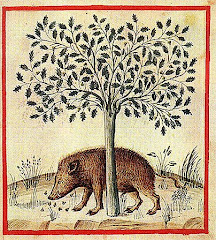 I don't know how many are familiar with the story of the Scythian Lamb or "Vegetable Lamb of Tartary" as it's also known.
I don't know how many are familiar with the story of the Scythian Lamb or "Vegetable Lamb of Tartary" as it's also known.I think the story is a lovely one and I have particular reason for appreciating it just now whilst I'm so absorbed in dyeing endless quantities of wool.
Most versions of the story tell of an Asian plant which grew little lambs instead of fruit at the top it's stem (or umbilical cord as it's often referred to).
The lamb, attached to the stem, would graze all the plants in the surrounding area until there was nothing left that it could reach. Eventually the lamb would die and all that would be left at the top of the plant was a puff of wool.
This story almost certainly developed as part of European attempts at understanding where cotton (a vegetable wool) came from, but there's always more than one thread of truth in every legend and for this one it's the Cibotium fern.
Unfortunately, copyright prevents me from uploading an image of a Cibotium in it's lambiest form, but here you can view the one held by the Natural History Museum which was part of a collection belonging to Sir Hans Sloane. It clearly shows why the idea of a vegetable lamb should have survived so long in history. For more details on the myths and facts surrounding the Scythian Lamb, there is an excellent account of the history here.
But back to the point, why am I flagging up Scythian Lambs in the first place?
With a bit of skewed logic, I came to the conclusion that if cotton could be considered a "vegetable lamb", there was no reason why wool couldn't be "animal cotton". And since I'm spending more and more time with wool because of its incredible affinity with vegetable dyes I decided I needed to make it an honorary herb of some some sort.
After all, it occurs to me that when so many of the people fascinated by plants (herbalists, botanists etc) are also keen spinners and weavers, the two areas are clearly spiritually related. But I'm a systematic kind of person so, if I start a herbal blog, the rule is that only herbs are allowed. The only way around that is to reclassify the things I want to talk about.
Of course, doing so also gives me the opportunity to highlight what is really a very enjoyable myth along with the opportunity to sport a wonderful picture of the Scythian Lamb itself.
As a sideline I found, whilst trawling unsuccessfully for a public domain image of the Cibotium lamb, an image from the front of the 1629 book by John Parkinson which I've never seen before. I fell in love with the image instantly and have to celebrate it here. Notice the Scythian lamb grazing (with some difficulty) in the background - and sorry it's so small.





















1 comment:
An excellent post really enjoyed it as a charming and un-common story. I do wonder if it may have some link to the myth of the Golden Fleece.
Post a Comment